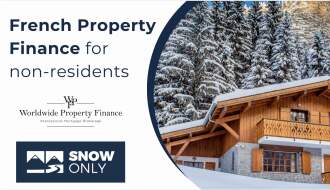In our latest podcast episode, SnowOnly's Mark Lightfoot sat down with Steve Thomas from Alpine Property Investments to discuss the best places to buy ski real estate in the French Alps. With over 18 years of experience and a deep understanding of around 300 ski resorts, Steve shared his invaluable insights into the ski property market.
Steve Thomas is a key member of the family-run business, Alpine Property Investments. With nearly two decades of experience in selling ski real estate, Steve has personally visited almost 70% of the ski resorts in the French Alps. His expertise provides listeners with top-notch advice on making smart investments in ski properties.
Who Will Benefit from Listening?
- Aspiring ski property investors
- Ski enthusiasts looking to buy their dream chalet or apartment
- Families seeking advice on family-friendly ski resorts
- Real estate investors interested in the French Alps market
Factors to Consider When Investing in Ski Real Estate
Steve highlighted the importance of looking at both rental returns and capital growth. He emphasized that high occupancy rates during winter and summer seasons can significantly boost rental income.
Best Resorts for Rental Returns and Capital Growth
Steve identified resorts with strong rental demand, like Châtel and Les Arcs, where demand often exceeds supply. He also discussed how new infrastructure projects, such as those in Le Bourg-d'Oisans, can drive up property values.
Dual Season Resorts and Their Benefits
Steve explained the advantages of investing in dual season resorts like Morzine. These resorts offer opportunities for rental income throughout both winter and summer, providing more stable returns.
Flagship vs. Satellite Resorts
The discussion compared well-known flagship resorts like Tignes and Val d'Isère with lesser-known satellite resorts. Steve pointed out that while flagship resorts have high prices, satellite resorts like Vaujany offer more affordable options with significant growth potential.
Upcoming Infrastructure Projects
Steve talked about the impact of new infrastructure projects on property values. He mentioned the upcoming international train station in Saint-Jean-de-Maurienne, which will connect major cities and increase the attractiveness of nearby resorts.
Choosing the Right Resort
Steve provided tips on how to choose the right resort based on individual needs. Factors like proximity to airports, family-friendly amenities, and the type of skiing available are crucial in making the right choice.
Wrapping Up the Conversation
In this engaging podcast episode, Mark Lightfoot and Steve Thomas explored the best places to buy ski real estate in the French Alps. From discussing rental returns and capital growth to comparing flagship and satellite resorts, they covered all the essential aspects of investing in ski properties. Steve’s expert insights provide valuable guidance for anyone looking to invest in this exciting market.
Tune in to the full episode to get all the details and expert advice you need to make informed decisions about ski real estate investments.
Full transcript
Mark Lightfoot: Welcome to another SnowOnly podcast. We're looking at the best places to buy ski real estate. Today, I'm delighted to be joined by Steve Thomas from Alpine Property Investments. Steve, yours is a family-run business, isn't it? You and your wife?
Steve Thomas: Yes, it's a family-run business. We've had 18 years of experience selling ski real estate. I've been to almost 70% of roughly around 300 ski resorts.
Mark: That's phenomenal. So, what Steve tells you is as good as you're going to get. Steve, I appreciate that it's a broad question, but if we can work through family resorts, infrastructures, and give the listeners some advice based on your knowledge, that would be great. Let's try to keep it to a nice 45 minutes. First of all, tell us a little about your company and what you do so we have some context.
Steve: Well, welcome. My name is Steve Thomas. I am one of the team at Alpine Property Investments and look after the sales side of things. We've been going for 18 years. As Mark said, we are a family business, and we started by purchasing a property in the Swiss Alps back in 2006. We've been through the process; we understand what makes a good purchase and what makes a bad purchase. We decided that we wanted to help people in terms of purchasing a property in the mountains through our experience of understanding where to buy and what to buy. This is why we're on this call, to discuss some of the things that we did ourselves when we purchased a property.
Mark: Obviously, there are many parameters to this in terms of the type of property—chalets, apartments, leasebacks, outright purchases, etc. So, in terms of the best places, what's the advice you tend to give to people if they're looking for an investment purchase? What's the golden rule of options from a general perspective?
Steve: If you're looking for an investment property, the main two things you're looking at are return on rental and return on capital. Some clients focus on rental income, while others look at the future of the particular resort, the ski domain, and the wider infrastructure. If we look at rental first, we're looking at dual seasons—winter and summer. For the best resorts, you need high occupancy levels where demand for the property almost exceeds supply. Anywhere from 65% to 80% occupancy in winter is normal. In terms of yields, you're looking at typically 2.5% to 4.5%, maybe 5%, net of agency fees and management costs. Resorts that excel in this tend to offer great skiing in winter and good infrastructure for getting people to the resorts, such as being close to an airport or train station, and of course, the ski domain itself.
In terms of return on capital, it's about what's happening in the resort and the wider area. For example, in Châtel a few years ago, the ski domain used to be almost like a horseshoe. When they circled the horseshoe, eliminating the need to take a bus from Linga to Super Châtel, prices increased by €1,500 to €2,000 per square meter. We have a similar situation happening in Le Bourg-d'Oisans, where a new international train station is being built. This will connect Paris to Lyon, to Saint-Jean-de-Maurienne, through a tunnel to Turin and onto Milan. This will drive investment and rental demand, as it significantly reduces travel time. Another factor impacting investment is the number of new projects in a resort. If a resort releases only two or three new projects every few years, it drives demand, which in turn drives prices up.
For example, in Vaujany, we're launching new chalets, and there hasn't been a chalet project in the Alpe d'Huez ski domain in over three or four years. This natural extension drives capital growth.
Mark: We could stop the podcast now because you've found the best places to buy ski property! If anyone's listening, we did it. I just want to go back to something you said earlier. When we're talking about ROI in terms of rentals, if you take a resort that is almost maxed out and won't put in any more property, is that where you would advise people to buy now?
Steve: It's a balance. If you have a resort that's maxed out with a high demand for the limited number of beds, then yes, you will see good returns. However, if you're looking at an up-and-coming resort linking to a bigger ski domain but still building, the ROI might be different because there's always another bed to put someone in. For ROI, you want to find a resort with good infrastructure, a long ski season, family-friendly amenities, and good accessibility. Resorts close to an airport or train station, with a good ski area, and infrastructure to meet various demands, such as ski schools for children or ski bars for older kids, are ideal.
For example, in La Tania, the ROI on rental for some apartments is 4% to 4.4%, net of agency fees. This is high because 75% of the clients are French, not relying on the international market. In resorts where there is a flood of new beds, you will see a dilution unless the marketing stream brings more clients to fill those beds.
Mark: Is it imperative that people buy in dual-season resorts nowadays? I had a good chat with someone about Val d'Isère, which is a massive flagship resort, but in the summer, it's just a bit cold and wet. Nothing really happens.
Steve: No, it's not imperative. If you're getting €2,000 a week in the winter for a three-bed apartment, in the summer, you may only get €500-600 a week. The dual-season nature is great if you want a dual-season base, but if your primary objective is to ski, you will get your biggest rental income in the winter. Some resorts like Méribel and Chamonix have good summer activities like golf and mountain biking. Resorts like Morzine are buzzing in the summer with cycling and mountain biking, making them great dual-season options. However, higher resorts like Val Thorens may not have a summer season but are excellent for winter.
Mark: Do you think rental prices in the summer will ever be as high as in the winter?
Steve: They're certainly increasing, and demand in the summer is growing. Resorts are realizing that summer is not a wasted few months. For example, Morzine is one of the best summer resorts. It's absolutely buzzing throughout the summer with activities like golf and mountain biking. Resorts are doing more to draw customers in the summer, but whether summer prices will ever match winter prices, I don't know. It depends on demand.
Mark: Is being close to Geneva imperative for international investors, or are resorts further away still good investments?
Steve: Proximity to Geneva is definitely appealing, especially for those flying in from places like the UK. Resorts within 75 minutes of Geneva, like Morzine, Chamonix, and Saint-Gervais, are popular because the last thing you want after a flight is a long drive. However, many people are still drawn to resorts like Tignes and Val d'Isère, even if they're further away, because of the skiing experience.
Mark: Are there any lesser-known resorts developing their infrastructure that could become flagship resorts in the next 5 to 10 years?
Steve: It's hard to say if they'll become flagship resorts like Courchevel 1850 or Val d'Isère, but there are hidden gems. For example, Vaujany is a dual-season resort with a cable car that takes you to 2,800 meters. In Le Bourg-d'Oisans, there's a new international train station that will transform the area, making it more accessible. Les Menuires and Saint-Martin-de-Belleville are also good options within the Three Valleys.
Mark: Do people ever buy in ski resorts they've never visited?
Steve: Absolutely. During COVID, we sold several properties where clients never visited. Some clients know the resort and just want a video tour of the site. We also had clients who did extensive research online and bought based on that. It's about trust and confidence in the information provided. If you can't visit, you need to decide whether to proceed or wait.
Mark: To summarize, we've talked about investment properties, family resorts, flagship vs. satellite resorts, infrastructure, airports, hospitals, dual seasons, and appreciation. It seems that infrastructure is a key factor for ski property investment. Would you agree?
Steve: Yes, 80 to 85% of our clients are looking to rent, so a good rental track record is crucial. After that, it's about what the resort offers—good skiing, accessibility, family-friendly amenities, and potential for capital appreciation.
Mark: Just for fun, let's do a quick-fire round. Best dual-season resort?
Steve: Morzine.
Mark: Best for families?
Steve: Vaujany.
Mark: Best skiing?
Steve: La Tania.
Mark: Best for investment?
Steve: Les Arcs.
Mark: Most convenient?
Steve: Geneva.
Mark: Best après-ski?
Steve: Val d'Isère.
Mark: Best scenery?
Steve: Samoëns.
Mark: Best snow?
Steve: Tignes.
Mark: Best tradition?
Steve: Megève.
Mark: Your favourite?
Steve: Le Bourg-d'Oisans.
Mark: Steve, thank you so much for your time



